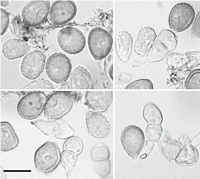|
 Puccinia austrina Puccinia austrina
BiostatusPresent in region - Indigenous. Endemic
Images (click to enlarge)
Caption: Fig. 3. Urediniospores and teliospores of Puccinia austrina McKenzie on Isolepis habra (Edgar) Soják (holotype). Bar 20 μm |
Article: McKenzie, E.H.C. (2008). Rust fungi in the subantarctic islands of New Zealand. Mycoscience 49: 1-10 Mycological Society of Japan.
Description: Uredinia amphigenous, cinnamon brown, bullate, pulverulent, elliptical, up to 2 cm long. Urediniospores 23–29 × (16–)18–21(–23) µm (mean of 44 spores, 25.7 × 19.6 µm), obovoid to subglobose, contents very pale golden brown; wall 1.5–3 µm thick, pale golden brown, echinulate, germ pores 2, equatorial. Telia arising from same sori as the uredinia. Teliospores 27–41 × 10–17 µm (mean of 20 spores, 32.4 × 14 µm), ellipsoid or subclavate, straight or slightly curved, apex rounded or sometimes acuminate, constricted at the septum, contents very pale luteus, wall ca. 1 µm thick at sides, 1–4 µm at apex, smooth, pale luteus; pedicels up to 15 µm long, but usually broken shorter, 5–9 µm wide,
hyaline.
Notes: Notes: This is the first record of a rust fungus on either Isolepis habra or I. subtilissima. McAlpine (1906) described Uredo scirpi-nodosi on Scirpus nodosus (= Ficinia nodosa (Rottb.) Goetgh., Muasya & D.A. Simpson; syn. Isolepis nodosa (Rottb.) R. Br.) from Victoria, Australia. He described the urediniospores as “brown, subglobose, ellipsoid to oblong, variable in size, 25–32 µ diam., or 27–36 × 19–25 µ; epispore echinulate, often 3 µ thick.” The species was subsequently reported from New Zealand (Cunningham 1924) and the urediniospores are described by Cunningham (1931) as “elliptical, obovate or subglobose, 24–35 × 16–24 µ, average 27 × 20 µ; epispore tinted cinnamon brown, coarsely and sparsely echinulate, 1.5 µ thick.” Cunningham (1924) stated that the epispore was 2–2.5 µm thick.
Further specimens of Uredo scirpi-nodosi in Herb. PDD were examined: PDD 61891 on Isolepis distigmatosa (C.B. Clarke) Edgar, PDD 34174 and 45171 on I. inundata R. Br., PDD 44048 on Ficinia nodosa, PDD 31479 and 41097 on I. prolifera (Rottb.) R. Br. These specimens had urediniospores measuring (23–)25–31(–35) × (16.5–)19–26(–28) µm (mean 120 spores, 27.8 × 22.6 µm). U scirpi-nodosi has been also recorded on Bolboschoenus medianus (V.J. Cook) Soják and Schoenoplectus tabernaemontani (C.C. Gmel.) Palla (= S. validus (Vahl) Á. Löve & D. Löve) in New Zealand (McKenzie 1998).
Gjærum (1990) described Puccinia isolepidis on Isolepis fluitans from Ethiopia. This rust has urediniospores that measure 21–27 × 13–21 µm, which is smaller than those described for Uredo scirpi-nodosi (McAlpine 1906). In addition, the urediniospore wall is only 1(–1.5) µm thick in P. isolepidis, compared to up to 3 µm in U. scirpi-nodosi. The teliospores of P. isolepidis are considerably larger than those of P. austrina (38–65 × 16–24 µm vs. 27–41 × 10–17 µm).
|